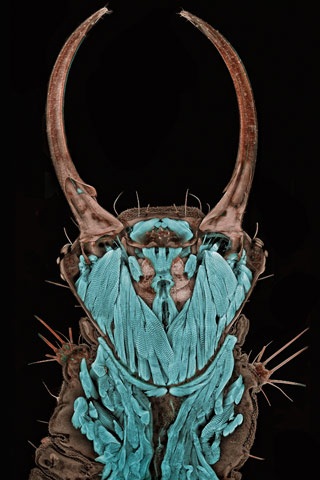THE 2011 Nikon Small World photomicrography competition has been won by this startling image of a Common Green Lacewing, taken by Dr Igor Siwanowicz of Wisconsin, USA. The judges praised the photograph for “demonstrating the beauty in ‘ugly”.
When the bug landed on his hand, Siwanowicz reacted like a true scientist: he took a test tube from his pocket and captured the beast as a potential photomicrography subject. Using a confocal microscope, he fixed and dyed the sample to create the winning image – a tricky procedure as the insect’s head is just 1.3mm in length.The method used meant he only had one chance to get an image.
“Every year, we receive spectacular images for the Nikon Small World Competition, and it is our privilege to honour the talented researchers and photomicrographers who submit their amazing work,” said Eric Flem, communications manager, Nikon Instruments. “Marrying technique and aesthetics is no easy feat, and we are proud that this competition is able to showcase beautiful imagery and demonstrate some of the many facets of science”.
Siwanowicz completed his doctoral studies in protein crystallography, but now works in invertebrate photography for research – so this competition must hold particular significance for him. “My art causes a dissonance – a conflict between the cultural perception of an insect as something repulsive with a newly-acquired admiration of the beauty of its form,” he said.
Top images from the 2011 Nikon Small World Competition will be used in Nikon’s 2012 calendar and displayed in a US museum tour.
All the winners
The following are the top 20 and honorable mentions for the 2011 Nikon Small World competition. The full gallery of winning images, along with Images of Distinction can be viewed at www.nikonsmallworld.com
Winner: Dr Igor Siwanowicz
Max Planck Institute of Neurobiology, Martinsried, Germany
Portrait of a Chrysopa sp. (green lacewing) larva (20x), Confocal
2nd: Dr Donna Stolz
University of Pittsburgh, USA
Blade of Grass (200x), Confocal stack reconstruction, Autofluorescence
3rd: Frank Fox
Fachhochschule Trier, Germany
Melosira moniliformis, living specimen (320x), Differential Interference Contrast
4th: Dr Robin Young
The University of British Columbia, Canada
Intrinsic fluorescence in Lepidozia reptans (liverwort) (20x), Live mount, Confocal microscopy
5th: Alfred Pasieka
Germany
Microchip surface, 3D reconstruction (500x), Incident light, Normarski Interference Contrast
6th: Dennis Callahan
California Institute of Technology, USA
Cracked gallium arsenide solar cell films (50x), Brightfield
7th: Gabriel Luna
UC Santa Barbara, Neuroscience Research Institute, USA
Retinal flatmount of mouse nerve fibre layer (40x), Laser Confocal Scanning
8th: Dr Bernardo Cesare
Department of Geosciences, Padova, Italy
Graphite-bearing granulite from Kerala (India) (2.5X), Polarized light
9th: Dr Jan Michels
Christian-Albrechts-Universität zu Kiel, Germany
Temora longicornis (marine copepod), ventral view (10x), Confocal, Autofluorescence and Congo Red Fluorescence
10th: Joan Röhl
Institute for Biochemistry and Biology, Potsdam, Germany
Daphnia magna (freshwater water flea) (100x), Differential Interference Contrast
11th: Dr Jan Michels
Christian-Albrechts-Universität zu Kiel, Germany
Ant head, frontal view (10x), Confocal, autofluorescence
12th: Thomas Deerinck
National Center for Microscopy and Imaging Research, USA
HeLa (cancer) cells (300x), 2-Photon fluorescence
13th: Dr Stephen S Nagy
Montana Diatoms, USA
Curare vine in cross-section, Chondrodendron tomentosum (45x), Brightfield, digitally inverted
14th: Yanping Wang
Beijing Planetarium, China
Sand (4x), Reflected light
15th: James Nicholson
Coral Culture and Collaborative Research Facility, USA
Porites lobata (lobe coral), live specimen (12x), Epifluorescence with triple band (U/B/G) excitation
16th: Dr Christopher Guérin
VIB (Flanders Institute of Biotechnology), Belgium
Cultured cells growing on a bio-polymer scaffold (63x), Confocal
17th: Dr Witold Kilarski
EPFL-Laboratory of Lymphatic and Cancer Bioengineering, Switzerland
Litomosoides sigmodontis (filaria worms) inside mouse ear (150X), Fluorescent confocal microscopy
18th: Benjamin Blonder, David Elliott
University of Arizona, USA
Venation network of young Populus tremuloides (quaking aspen) leaf (4x), Brightfield
19th: Dr Donna Stolz
The University of Pittsburgh, USA
Mammalian cell collage stained for various proteins and organelles, assembled into a wreath (200-2000x), Single slice confocal cell mosaic
20th: Douglas Moore
University of Wisconsin, USA
Agatized dinosaur bone cells, unpolished, ca. 150 million years old (42x), Stereomicroscopy
Honorable Mentions
Jose R. Almodovar, UPR Mayaguez Campus, Puerto Rico, USA
Dr Paul Appleton, University of Dundee, UK
Dr Pedro Barrios-Perez, National Research Council of Canada
Dr Jorge Bernardino de la Serna, Memphys, Denmar
Gerd Guenther, Duesseldorf, Germany (two mentions)
Dr Marta Guervos, University of Oviedo, Spain
Charles Krebs, Charles Krebs Photography, USA
Dr David Maitland, Feltwell, UK
Poulomi Rays, Clemson University, USA
Kevin Smith, MetPrep, UK
Wim van Egmond, Micropolitan Museum, Netherlands
Yanping Wang, Beijing Planetarium, China
Dr Torsten Wittmann, University of California, USA

